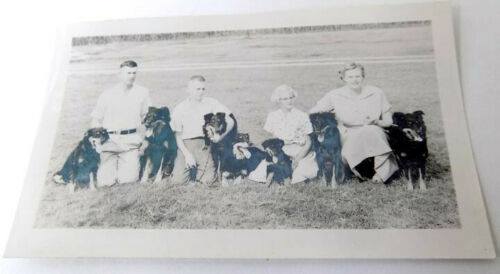As World War II progressed, farmers were being asked to produce more food with fewer workers. More and more young men were being drafted or enlisted in the military. The farm labor shortage became severe, especially for fruit and vegetable producers. In the course of the war, 15 million men and women were called up into the military. At the time, the entire workforce consisted of only 73 million people. Over 20 percent of the pre-war workforce were now in the military, not working at their civilian jobs. The nation needed new ways to get the work done. It was during this time that farm dog utilization probably peaked in America. Over the ensuing decades, mechanized farming and other factors led to a decline in the use of farm dogs. This period saw a decline in farm dogs and farm dog breeders. Finally, about twenty years ago, the Black and Tan English Shepherd breeder population began to narrow and eventually dwindle to almost non-existence. Today, of that last generation of ESBT breeders, about a dozen or so individuals and families are still with us. With few exceptions, these last ESBT breeders are retired. In varying degrees, I have a relationship with many of the ESBT breeders of the Southeast. With some of them, I have only had a few phone conversations. Others have visited my ranch or I have visited theirs. Almost all of them live within a few hours of me. Two months ago, I began to take a survey of the ESBT breeders I know. Through phone and email, I asked them all the following questions:
- What breeders or dogs are/were most influential on your breeding program?
- What traits do/did you select for in your breeding dogs?
- Do/did sheepdog herding trials influence your breeding program?
- Do you have any additional comments about the bloodline that you’d like to express?
For the first question, “What breeders or dogs are/were most influential on your breeding program?” all respondents stated that John and Pauline Blankenship had some or much influence on their breeding program. Other influential breeders mentioned were Janice Sallee, and Edna Rogers. For the question, “Do/did sheepdog herding trials influence your breeding program?“ all respondents answered no. Surprised by the unanimous answer, I did reach out to a friend of the Blankenships about their involvement in competitive herding trials. He recalled that they did participate in herding trials. But for the ESBT breeder generation following the Blankenships, herding trials were seemingly not an influence. In a future post, I’ll analyze that further, and I’ll discuss the answers to questions #2 and #4.
For this post, I’ll close with an observation. There is little to no influence by Tom Stodghill or his brand of ESBT dog here in the Southeast. Both geography and culture play a significant role in selecting working dogs, and the geography/culture of the Southeast is quite different than that of Texas and the West. Geographically, we lack the wide-open spaces found in Texas and much of the West. We have a lot of tight spaces and dense woodlands here in the rural Southeast. Our geography calls for a different type of working dog. Culturally, rural Southeasterners are a conservative, insular group who would not give much traction to Stodghill’s extroverted, big-talking style. When one considers geography and culture, it is a natural occurrence that the ESBT strains of the Southeast and Texas would grow separated. Few if any of the dog buyers I speak with in the Southeast have even heard of Tom Stodghill. Conversely, almost all have had a Blankenship dog on their family farm.

